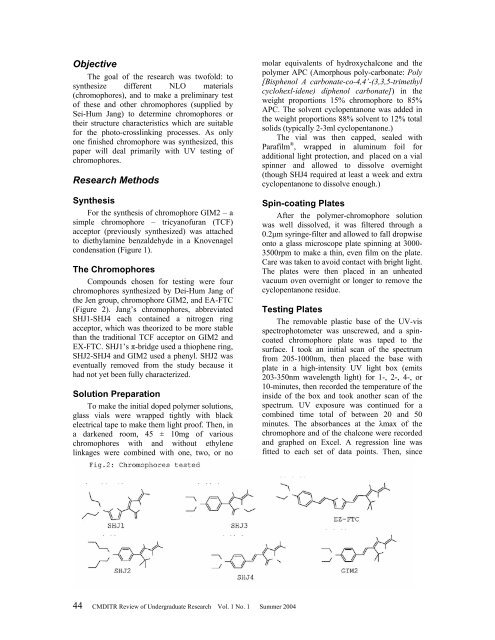CMDITR Review of Undergraduate Research - Pluto - University of ...
CMDITR Review of Undergraduate Research - Pluto - University of ...
CMDITR Review of Undergraduate Research - Pluto - University of ...
You also want an ePaper? Increase the reach of your titles
YUMPU automatically turns print PDFs into web optimized ePapers that Google loves.
Objective<br />
The goal <strong>of</strong> the research was tw<strong>of</strong>old: to<br />
synthesize different NLO materials<br />
(chromophores), and to make a preliminary test<br />
<strong>of</strong> these and other chromophores (supplied by<br />
Sei-Hum Jang) to determine chromophores or<br />
their structure characteristics which are suitable<br />
for the photo-crosslinking processes. As only<br />
one finished chromophore was synthesized, this<br />
paper will deal primarily with UV testing <strong>of</strong><br />
chromophores.<br />
<strong>Research</strong> Methods<br />
Synthesis<br />
For the synthesis <strong>of</strong> chromophore GIM2 – a<br />
simple chromophore – tricyan<strong>of</strong>uran (TCF)<br />
acceptor (previously synthesized) was attached<br />
to diethylamine benzaldehyde in a Knovenagel<br />
condensation (Figure 1).<br />
The Chromophores<br />
Compounds chosen for testing were four<br />
chromophores synthesized by Dei-Hum Jang <strong>of</strong><br />
the Jen group, chromophore GIM2, and EA-FTC<br />
(Figure 2). Jang’s chromophores, abbreviated<br />
SHJ1-SHJ4 each contained a nitrogen ring<br />
acceptor, which was theorized to be more stable<br />
than the traditional TCF acceptor on GIM2 and<br />
EX-FTC. SHJ1’s π-bridge used a thiophene ring,<br />
SHJ2-SHJ4 and GIM2 used a phenyl. SHJ2 was<br />
eventually removed from the study because it<br />
had not yet been fully characterized.<br />
Solution Preparation<br />
To make the initial doped polymer solutions,<br />
glass vials were wrapped tightly with black<br />
electrical tape to make them light pro<strong>of</strong>. Then, in<br />
a darkened room, 45 ± 10mg <strong>of</strong> various<br />
chromophores with and without ethylene<br />
linkages were combined with one, two, or no<br />
molar equivalents <strong>of</strong> hydroxychalcone and the<br />
polymer APC (Amorphous poly-carbonate: Poly<br />
[Bisphenol A carbonate-co-4,4’-(3,3,5-trimethyl<br />
cyclohexl-idene) diphenol carbonate]) in the<br />
weight proportions 15% chromophore to 85%<br />
APC. The solvent cyclopentanone was added in<br />
the weight proportions 88% solvent to 12% total<br />
solids (typically 2-3ml cyclopentanone.)<br />
The vial was then capped, sealed with<br />
Parafilm ® , wrapped in aluminum foil for<br />
additional light protection, and placed on a vial<br />
spinner and allowed to dissolve overnight<br />
(though SHJ4 required at least a week and extra<br />
cyclopentanone to dissolve enough.)<br />
Spin-coating Plates<br />
After the polymer-chromophore solution<br />
was well dissolved, it was filtered through a<br />
0.2µm syringe-filter and allowed to fall dropwise<br />
onto a glass microscope plate spinning at 3000-<br />
3500rpm to make a thin, even film on the plate.<br />
Care was taken to avoid contact with bright light.<br />
The plates were then placed in an unheated<br />
vacuum oven overnight or longer to remove the<br />
cyclopentanone residue.<br />
Testing Plates<br />
The removable plastic base <strong>of</strong> the UV-vis<br />
spectrophotometer was unscrewed, and a spincoated<br />
chromophore plate was taped to the<br />
surface. I took an initial scan <strong>of</strong> the spectrum<br />
from 205-1000nm, then placed the base with<br />
plate in a high-intensity UV light box (emits<br />
203-350nm wavelength light) for 1-, 2-, 4-, or<br />
10-minutes, then recorded the temperature <strong>of</strong> the<br />
inside <strong>of</strong> the box and took another scan <strong>of</strong> the<br />
spectrum. UV exposure was continued for a<br />
combined time total <strong>of</strong> between 20 and 50<br />
minutes. The absorbances at the λmax <strong>of</strong> the<br />
chromophore and <strong>of</strong> the chalcone were recorded<br />
and graphed on Excel. A regression line was<br />
fitted to each set <strong>of</strong> data points. Then, since<br />
44 <strong>CMDITR</strong> <strong>Review</strong> <strong>of</strong> <strong>Undergraduate</strong> <strong>Research</strong> Vol. 1 No. 1 Summer 2004




